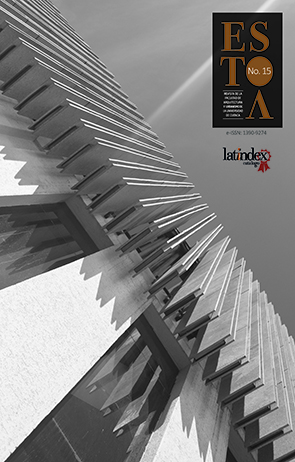Lighting shadows
Approaches and experiences for accessible heritage
DOI:
https://doi.org/10.18537/est.v008.n015.a08Keywords:
built heritage, visual disability, accessibility, experiential walk, participationAbstract
The investigation Illuminating Shadows seeks to provide people with visual disabilities with the necessary resources so that, during a visit to a building of the built heritage of the city of Cordoba, Argentina, they can imagine what the reality that they have in front of them is like and what it contains, aspiring to have each one manage their own route. This paper presents theoretical and methodological reflections on this subject, and the results of their application after a first visit experience. In a qualitative sense, the approach chosen as a methodological modality is Study-Action, which implies a special epistemology and nosological perspective. In addition, a perspective and experiential logic of active conservation was adopted, where the objective is the enrichment of the collective memory, the recognition of its authenticity and changing values, and its appropriation by the community.
Downloads
References
Alderoqui, S. (2012). De la relación compleja entre la educación en museos y las experiencias de los visitantes. En S. Alderoqui (Ed.), Los visitantes como patrimonio (pp. 30-39). Buenos Aires, Argentina: Universidad Nacional de Lujan.
Arnheim, R. (1990). Perceptual aspects of art for the blind. Journal of Aesthetic Education, 24 (3), 57-65.
Bellini, A. (1999). De la restauración a la conservación; de la estética a la ética. Loggia, Arquitectura & Restauración, (9) 10-15. doi: 10.4995/loggia. 2000.5245
Berger, J. (2005). Modos de ver. Barcelona, España: GG.
Chillida, E. (2005). Escritos. Madrid, España: La Fábrica.
Coma Quintana, L. y Santacana I Mestre, J. (2010). Ciudad educadora y patrimonio. Guijón, España: Trea.
Di Felice, M. (2012). Paisajes posurbanos. Córdoba, Argentina: Ediciones del Copista.
Dosio, P. (2006), Apuntes sobre el arte de los no videntes. Buenos Aires, Argentina: Integrando, Fundación Artistas Discapacitados. Recuperado el día 5 de abril de 2018 de https://goo.gl/PRFYba
Espósito, R. (2016). Las personas y las cosas. Madrid, España: Katz.
Espósito, R. (2017). Personas, cosas, cuerpos. Madrid, España: Trotta.
Fals Borda, O. (2009). Una sociología sentipensante para América Latina. Bogotá, Colombia: CLACSO.
García Valecillo, Z. (2009). ¿Cómo acercar los bienes patrimoniales a los ciudadanos? Pasos, Revista de Turismo y Patrimonio Cultural, 7 (2), 271-280.
Han, B-C (2015). La sociedad del cansancio. Burzaco, Argentina: Herder.
Han, B-C (2017). La expulsión de lo distinto. Burzaco, Argentina: Herder.
Liendivit, Z. (2009). La ciudad como problema estético. Buenos Aires, Argentina: Contratiempo Ediciones.
Lipovetsky, G. y Serroy, J. (2015). La estetización del mundo. Barcelona, España: Editorial Anagrama.
Maurette, P. (2015). El sentido olvidado. Ensayos sobre el tacto. Buenos Aires: Mardulce.
Mirzoeff, N. (2016). Cómo ver el mundo. Barcelona, España: Paidós.
Mitchell, W. J. T. (1994). Narrative, memory, and Slavery. En, M. J. M. Ezell & K. O'Brien O'Keeffe (Ed.). Artifacts and the Production of Meaning: The Page, the Image, and the Body (pp. 199-222). Ann Arbor, United States: University of Michigan Press.
Noguera Giménez, J. F. (2002). La conservación activa del patrimonio arquitectónico. Loggia, Arquitectura & Restauración, (13), 10-31. doi: 10.4995/loggia. 2002.3569
Schlögel, K. (2007). En el espacio leemos el tiempo. Madrid, España: Siruela.
Toop, D. (2013). Resonancia siniestra. Buenos Aires, Argentina: Caja Negra.
Wagensberg, J. (2005). La rebelión de las formas. Barcelona, España: Metatemas.
Zamora Águila, F. (2015). Filosofía de la imagen. Ciudad de México, México: UNAM.
Published
How to Cite
Issue
Section
License
The Journal declines any responsibility for possible conflicts derived from the authorship of the works that are published in it.
The University of Cuenca in Ecuador conserves the patrimonial rights (copyright) of the published works and will favor the reuse of the same ones, these can be: copy, use, diffuse, transmit and expose publicly.
Unless otherwise indicated, all contents of the electronic edition are distributed under a Creative Commons Attribution-NonCommercial-ShareAlike 4.0 International License.




